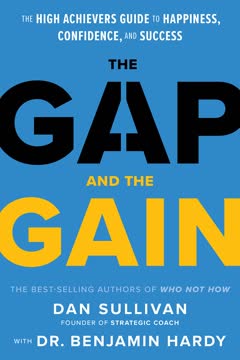Key Takeaways
1. Overcome fear and build confidence to effectively sell price increases
In every price increase conversation, the person who exerts the greatest emotional control has the highest probability of achieving their desired outcome.
Fear of rejection is the biggest obstacle for salespeople when approaching price increase conversations. This fear is deeply rooted in human evolution, as rejection once meant potential death for our ancestors. To overcome this, salespeople must:
- Develop "obstacle immunity" by intentionally seeking out rejection and uncomfortable situations
- Practice emotional self-control through techniques like positive visualization and self-talk
- Focus on preparation and practice to build confidence
By mastering these skills, salespeople can approach price increase conversations with relaxed, assertive confidence, significantly improving their chances of success.
2. Protect customer relationships while implementing price increases
Nobody likes a price increase, but they'll accept it when you treat them with respect, give them a reasonable explanation, invest in the relationship, and deliver value.
Proactive relationship management is crucial for successful price increases. To protect and strengthen customer relationships:
- Consistently deliver value and solve problems for customers
- Invest in building deep, personal connections with key stakeholders
- Communicate transparently and give customers advance notice of price increases
- Appeal to customers' sense of fairness and reciprocity
By focusing on these aspects, salespeople can make it "hard to break up" with them, reducing the risk of losing customers during price increase initiatives.
3. Follow a systematic approach to price increase conversations
Winging it and leaving outcomes to chance is exceedingly stupid.
The Five-Step Price Increase Sales Process provides a framework for successful conversations:
- Set the stage
- Prepare
- Make your case
- Leverage the assumptive close
- Handle objections and negotiate
This process helps salespeople:
- Reduce anxiety and increase confidence
- Improve consistency and predictability of outcomes
- Ensure thorough preparation and effective execution
By following this systematic approach, salespeople can significantly increase their chances of securing price increases while maintaining positive customer relationships.
4. Craft compelling narratives and messages for price increases
Vivid, customer-centric narratives grease the skids of price increase acceptance.
Eight price increase narratives form the building blocks of effective messaging:
- Economic fairness
- Maintain quality
- Continue services
- Reverse value
- Reciprocity
- Past value
- Present value
- Future value
When crafting messages:
- Use the "because" statement framework to increase compliance
- Tailor narratives to each customer's unique situation
- Focus on answering the customer's "What's in it for me?" (WIIFM) question
- Ensure authenticity and transparency in communication
By mastering these narratives and messaging techniques, salespeople can more effectively communicate the value and necessity of price increases to their customers.
5. Master the art of closing and handling objections in price increase discussions
After you put the price increase on the table, be silent. Despite the alarm bells going off in your adrenaline-soaked mind, despite your pounding heart, sweaty palms, and fear, bite your tongue and give your customer space to respond.
The assumptive close is the most effective technique for securing price increases. To execute it successfully:
- Deliver a confident because statement
- State the price increase effective date
- Shut up and wait for the customer's response
When handling objections:
- Use the "ledge" technique to interrupt the fight-or-flight response
- Apply the four situational frameworks: Just let them vent, Enroll them, Space and time, Relate-Explain-Confirm
- Stay calm and maintain emotional control throughout the conversation
By mastering these closing and objection-handling techniques, salespeople can navigate even the most challenging price increase conversations with confidence and success.
6. Negotiate price increases strategically to maximize profits
When you feel that you don't have value to articulate, it is easy to make the mistake of delivering a purely fact-based message. What you must not forget is that humans base acceptance on emotions first. We feel first, then think.
The D.E.A.L. Negotiation Framework provides a structure for effective price increase negotiations:
- Discover: Clarify and understand the customer's position
- Explain: Defend your position with compelling value narratives
- Align: Use give-and-take strategies to reach an agreement
- Lock: Secure tangible confirmation of the agreed-upon price increase
Key strategies for successful negotiations:
- Leverage "funny money" concessions to protect price increase points
- Use precise, irregular increments when making concessions
- Prepare a Give-Take Playlist in advance
- Focus on the value equation: Measurable Business Outcomes + Emotional Outcomes - Price = Value
By applying these negotiation strategies, salespeople can maximize profits while maintaining positive customer relationships.
7. Lead and coach teams through successful price increase initiatives
You need your people more than they need you.
The Three Pillars of Leadership Excellence for price increase initiatives are:
- Leading: Shaping strategy and inspiring vision
- Managing: Organizing, planning, and directing tactics
- Coaching: Developing people through training and feedback
To effectively lead price increase initiatives:
- Clearly articulate the "why" behind the initiative
- Align compensation and incentives with price increase goals
- Provide comprehensive training and support for the sales team
- Monitor progress and offer ongoing coaching and feedback
By excelling in these leadership areas, managers can transform their sales teams into price increase machines, driving significant revenue and profit growth for their organizations.
Last updated:
FAQ
What's "Selling the Price Increase" about?
- Overview: "Selling the Price Increase" by Jeb Blount is a comprehensive guide for B2B sales professionals on how to effectively raise prices without losing customers.
- Purpose: The book aims to equip sales teams with strategies, tactics, and techniques to approach price increase conversations confidently and gain acceptance from customers.
- Structure: It is divided into six parts, each focusing on different aspects of selling price increases, from managing fear to closing deals and leading initiatives.
- Target Audience: The book is intended for frontline sales professionals, account managers, and sales leaders who wish to improve their skills in handling price increases.
Why should I read "Selling the Price Increase"?
- Skill Development: It provides a systematic approach to mastering the art of selling price increases, a critical skill for sales professionals.
- Practical Advice: The book offers actionable strategies and real-world examples that can be directly applied to sales scenarios.
- Confidence Building: It helps salespeople overcome the fear of rejection and approach price increase conversations with confidence.
- Leadership Insights: Sales leaders can learn how to effectively coach and lead their teams through price increase initiatives.
What are the key takeaways of "Selling the Price Increase"?
- Fear Management: The book emphasizes the importance of managing the fear of rejection and developing emotional self-control.
- Customer Relationships: Maintaining and protecting customer relationships is crucial when implementing price increases.
- Structured Approach: It introduces a five-step sales process for price increases, including setting the stage, preparing, making your case, closing, and handling objections.
- Leadership Role: Effective leadership and coaching are essential for successful price increase initiatives.
How does Jeb Blount suggest handling objections in "Selling the Price Increase"?
- Emotional Control: The book stresses the importance of maintaining emotional control during objection handling to achieve desired outcomes.
- Ledge Technique: Blount introduces the "ledge" technique, which involves using memorized responses to buy time and regain composure.
- Listening: Encourages letting customers vent their frustrations and listening actively to understand their concerns.
- Clarification: Use open-ended questions to clarify objections and isolate what must be negotiated.
What is the "Price Increase Because Statement" framework in "Selling the Price Increase"?
- Framework Steps: The framework consists of five steps: Impact, Amount, Because, WIIFM Answer, and Timing.
- Purpose: It provides a structured way to communicate the reason for a price increase, making it more likely for customers to accept it.
- Clarity and Simplicity: The framework emphasizes keeping the message simple and clear to avoid confusion and resistance.
- Application: It is particularly useful for presenting or defending price increases in low- to medium-risk situations.
How does "Selling the Price Increase" address the fear of rejection?
- Understanding Fear: The book explains that the fear of rejection is a natural human response and not a psychological problem.
- Obstacle Immunity: It suggests developing "obstacle immunity" by repeatedly facing rejection to build resilience.
- Emotional Awareness: Encourages awareness of emotions to manage them effectively during price increase conversations.
- Confidence Building: Provides techniques to bolster confidence, such as changing self-talk and using positive visualization.
What are the "Three Pillars of Leadership Excellence" in "Selling the Price Increase"?
- Leading: Focuses on shaping strategy and inspiring people through vision and emotional connection to a future state.
- Managing: Involves organizing, planning, and directing to drive outcomes and ensure effective execution.
- Coaching: Emphasizes developing people through training, observation, and feedback to improve performance.
- Alignment: Successful price increase initiatives require alignment across all three pillars for optimal results.
What role does emotional contagion play in "Selling the Price Increase"?
- Mirroring Emotions: Emotional contagion refers to the tendency of people to mirror the emotions of those around them.
- Confidence Transfer: When salespeople approach conversations with confidence, customers are more likely to respond positively.
- Impact on Outcomes: The book highlights that emotional contagion can significantly influence the success of price increase conversations.
- Practical Application: Sales professionals are encouraged to project relaxed, assertive confidence to achieve better results.
How does "Selling the Price Increase" suggest setting the stage for price increases?
- Priming Customers: The book recommends priming customers for change by suggesting that a price increase is likely in the future.
- Giving Heads Up: Advises giving customers a heads-up about impending price increases to reduce resistance.
- Leveraging Reciprocity: Encourages using the Law of Reciprocity by providing value to customers, making them more likely to accept increases.
- Formal Appointments: Suggests setting formal appointments for price increase conversations to ensure professionalism and transparency.
What are the eight price increase narratives in "Selling the Price Increase"?
- Economic Fairness: Focuses on rising costs and economic pressures as reasons for price increases.
- Maintain Quality: Emphasizes the need to maintain high-quality standards.
- Continue Services: Justifies increases to continue providing services that have become unprofitable.
- Reverse Value: Offers customers the choice to pay more for valued services or lose them.
- Reciprocity, Past, Present, and Future Value: These narratives highlight the value delivered in the past, present, and future to justify price increases.
What are the best quotes from "Selling the Price Increase" and what do they mean?
- "In every price increase conversation, the person who exerts the greatest emotional control has the highest probability of achieving their desired outcome." This quote emphasizes the importance of emotional discipline in successful price increase conversations.
- "You need your people more than they need you." Highlights the critical role of leadership in supporting and empowering sales teams during price increase initiatives.
- "Confidence is the key ingredient." Stresses that projecting confidence is crucial for gaining customer acceptance of price increases.
- "The most effective way to sell price increases without losing customers is to earn it by just doing your job." Underlines the importance of consistently managing accounts and delivering value to justify price increases.
How does "Selling the Price Increase" suggest using the D.E.A.L. framework for negotiation?
- Discover: Clarify and understand the customer's position before negotiating.
- Explain: Defend your position by reiterating the reasons for the price increase and the value provided.
- Align: Engage in give-and-take to reach a mutually beneficial agreement while protecting price increase points.
- Lock: Secure the agreement with tangible confirmation, such as a signed contract or purchase order.
Review Summary
Selling the Price Increase receives mixed reviews, with an average rating of 3.75/5. Positive reviews praise its practical strategies for navigating price increase discussions, describing it as an "Army Field Manual" for sales professionals. Critics appreciate the actionable tactics and insights for both individual contributors and managers. Some readers found it repetitive or focused too much on fear. Overall, reviewers consider it valuable for B2B sales environments and small business owners dealing with inflation and price adjustments.
Similar Books










Download PDF
Download EPUB
.epub digital book format is ideal for reading ebooks on phones, tablets, and e-readers.













